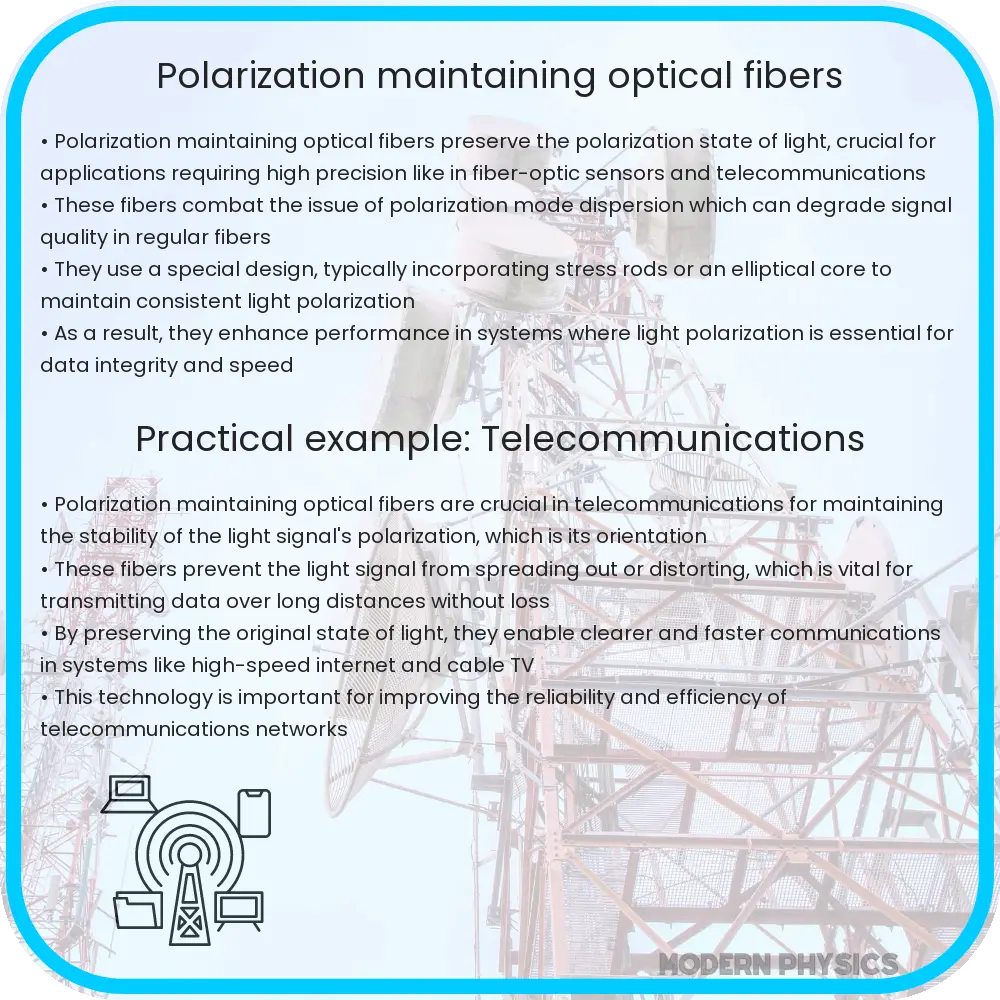Explore how Polarization Maintaining Fibers revolutionize optical technology with unmatched stability, precision, and clarity across various applications.

Understanding Polarization Maintaining Fibers
Polarization Maintaining (PM) Fibers are specialized optical fibers designed to preserve the polarization state of light as it travels through the fiber. This characteristic is crucial for applications that require a high degree of polarization stability, precision, and clarity, such as in fiber optic sensors, telecommunications, and medical imaging systems. PM fibers ensure that the light’s polarization, or the orientation of its electric field, remains unchanged despite any external influences that typically cause random polarization changes in standard fibers.
Key Attributes of PM Fibers
- Stability: PM fibers offer exceptional stability in preserving the polarization state of light over long distances and time periods. This stability is vital for applications where variations in polarization can lead to significant errors or loss of information.
- Precision: The ability to maintain a specific polarization state allows for precise control over the light’s properties. This precision is essential in systems requiring high accuracy, such as interferometric sensors and quantum computing.
- Clarity: By eliminating the distortions associated with random polarization changes, PM fibers provide clearer signal transmission. This clarity is crucial in optical communication systems, where maintaining the integrity of transmitted data is paramount.
How PM Fibers Work
PM fibers achieve polarization maintenance through their unique design, which incorporates an asymmetric core or stress-applying parts. These elements create a birefringent effect, where two orthogonal polarization modes propagate at slightly different speeds. By aligning the light’s polarization with one of these modes, PM fibers ensure that it remains stable and unaffected by external conditions such as temperature fluctuations or mechanical stress.
Applications of PM Fibers
- Fiber Optic Sensing: In fiber optic sensors, PM fibers are used to accurately measure physical parameters like temperature, strain, and pressure without the interference of polarization fluctuations.
- Telecommunications: In optical communications, PM fibers are essential for transmitting polarization-sensitive signals over long distances with minimal distortion or loss.
- Medical Imaging: Advanced imaging techniques, such as Optical Coherence Tomography (OCT), rely on PM fibers for high-resolution, polarization-sensitive imaging.
Challenges and Considerations in Using PM Fibers
Despite their advantages, PM fibers come with their set of challenges. The precise alignment of the fiber’s polarization axes with the light source and other optical components is crucial, requiring sophisticated equipment and expertise. Additionally, PM fibers tend to be more expensive than standard fibers due to their complex manufacturing process. Environmental factors, such as temperature and mechanical stress, can still influence the polarization state, albeit to a much lesser extent than in non-PM fibers. Therefore, careful handling and installation are essential to fully leverage the benefits of PM fibers.
Advancements and Future Directions
The field of polarization maintaining fibers is continuously evolving, with research and development efforts aimed at enhancing their performance and expanding their applications. Innovations in fiber design, materials, and manufacturing processes are underway to reduce costs, improve environmental robustness, and achieve higher levels of polarization purity. As these technologies advance, we can anticipate broader adoption of PM fibers across various sectors, including aerospace, defense, and beyond.
Conclusion
Polarization Maintaining Fibers stand at the forefront of optical technology, offering unparalleled stability, precision, and clarity for a wide range of critical applications. From enhancing the performance of fiber optic sensors to enabling clearer and more reliable communications, PM fibers are integral to the advancement of modern optical systems. Despite the challenges associated with their use, ongoing advancements promise to mitigate these issues, broadening the potential for PM fibers even further. As we continue to push the boundaries of what is possible with optical technology, Polarization Maintaining Fibers will undoubtedly play a pivotal role in shaping the future of telecommunications, sensing, and imaging.
